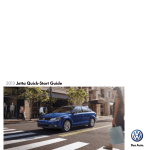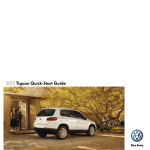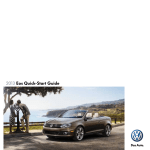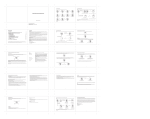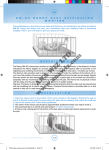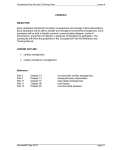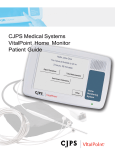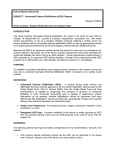Download Volkswagen 2012 User's Manual
Transcript
Speaking Volkswagen Your 2012 Passat Quick-Start Guide B L U E T O O T H® KE Y F O B & R E M OTE S TA R T CONNECTING YOUR BLUETOOTH-EQUIPPED CELL PHONE TO YOUR PASSAT 1 Make sure the Passat is parked. 2 Make sure your cell phone is Bluetooth enabled. 3Turn on the ignition. The Bluetooth feature goes into “discovery” mode for five minutes. 4From your Bluetooth menu on your phone, search for new devices. 5Your cell phone should offer a list of devices for you to choose from. Select the device “VW Phone.” 6Enter the passcode “0000” into your phone and press “pair.” Your phone should be connected to the Bluetooth system. 7The multi-function display will prompt you to create a user profile—press “OK.” NOTE: To allow Bluetooth to reconnect automatically each time you enter your car, be sure to set “VW Phone” as a “trusted device” on your phone (this varies from phone to phone, and may not be necessary on your specific device). TO ANSWER AN INCOMING CALL When you get a call, Bluetooth will interrupt your radio. You’ll hear a ringtone over your car’s speakers. Press the phone button A on the multi-function steering wheel. Learn more at vw.com/passat2012 BLUETOOTH VOICE RECOGNITION DIAL BY NUMBER Just say the number you want to call, and your VW will dial it for you. 1 Press and hold the microphone button B until you hear a musical chime. Your Volkswagen’s Bluetooth system will say “Main menu.” 2 After you hear a beep, say “Dial Number.” 3 The system will respond “Number please.” 4 After the beep, say the number. (You do not have to include “1” before the area code.) 5 The system will repeat the number, and then say “Continue.” 6 To tell the system to call the number, say “Call.” DIAL BY NAME Just say the name of someone in your phonebook, and your VW will dial for you. 1 Press and hold the microphone button B until you hear a musical chime. Your Volkswagen’s Bluetooth system will say “Main menu.” 2 After you hear a beep, say “Call” followed by the name of the person you want to call. For example, “Call Mike Brown.” 3 The system will answer “Calling FIRST NAME LAST NAME.” REDIAL You can tell your VW to redial the most recently dialed number. 1 Press and hold the microphone button B until you hear a musical chime. Your Volkswagen’s Bluetooth system will say “Main menu.” 2 After the beep, say “Redial.” 3 The system will respond “Redial. Dialing.” A Your Passat comes standard with style. And that’s just the beginning. You’ll discover dozens of great features inside, too. Because at Volkswagen, we want to be sure that you’re getting the most out of your time behind the wheel. So we’ve created this guide to help you get started, and to show you how quickly you’ll be speaking fluent Volkswagen. B This Guide is not a substitute for the Owner’s Manual. You must read it and the warnings included in it. HELP You can ask your Volkswagen to help you use voice commands. 1 You will hear a musical chime. Your Volkswagen’s Bluetooth system will say “Main menu.” 2 After the beep, say “Help.” 3 The system will respond “Help. Say a name plus ‘call,’ ‘dial number,’ ‘redial.’ You can also say ‘music,’ or ‘further options.’ To stop this dialogue at any time, say ‘cancel.’” Important Warnings and Safety Information, which you must read, are listed on the last panel, under BLUETOOTH® WARNINGS. B A CUSTOMIZING YOUR KEY FOB To customize which doors lock or unlock when you press the key fob, use the multi-function display buttons on the right side of the steering wheel. Make sure your vehicle is parked. Your car won’t let you do this while you’re driving. 1 Press the menu button A until you see the screen labeled “Settings” on the multi-function display in your instrument cluster. 2 Press the down arrow to scroll to “Convenience.” Press OK B . 3 Scroll down to “Door Open.” Press OK B . 4 Press OK again to select “Manual.” This allows you to adjust which doors lock or unlock when the key fob is pressed once. Select “All Doors:” All doors unlock when you press the key fob “Unlock” button—or when you open the driver’s door. Select “Single Door:” Only the driver’s side door will unlock. NOTE: Keyless access works differently in this setting. If you open the front passenger’s door, the driver’s door will simultaneously unlock. Select “Vehicle Side:” Both doors on the driver’s side will unlock when you open the driver’s door. 5 Press OK (B) to select or deselect the desired option. Program the doors to unlock when you remove the key from the ignition: 1 Make sure your vehicle is parked. 2 Press the menu button A on your steering wheel until you see the screen labeled “Settings” on the multi-function display in your instrument cluster. 3 Press the down arrow to scroll to “Convenience.” Press OK B . 4 Scroll down to “Door Open.” Press OK. 5 Scroll down to “Automatic.” Press OK. 6 Scroll down to “Auto Open.” Press OK to check the box. 7 From now on, when you remove your key from the ignition, the doors will automatically unlock. REMOTE START Before you remote start, make sure that: 1 All doors (including the fuel door and trunk) and windows are shut. 2 Doors are locked. 3 Fuel light is not on. Then you can remote start: 1 Press the lock button on the key fob. 2 Double-press the x2 button C within two seconds. 3 Your car will shut off if you hit the unlock button, open the door or trunk, or just have your hand in the front door handle. 4 After starting your car remotely, it will only run for ten minutes. 5 If you use remote start twice within ten minutes, you must start the car manually. 6 If you hit unlock, the car will lock automatically 30 seconds later if you haven’t entered the car. TO OPEN Make sure you have your key fob with you. Then just pull the door handle to unlock and open the door. NOTE: You can customize which doors unlock when you stand near the driver’s door with your key fob. For example, you can program only the driver’s door to unlock, or all doors to unlock. TO START 1 When starting the car, the key fob must be in the car cabin. Otherwise the “Key not in range” message will appear on the multi-function display. 2 Press down the brake pedal. 3 Push the START/STOP button D . TO STOP NOTE: Be sure not to stand too close to the vehicle for prolonged periods of time with the key on your person, as it may drain the battery. Learn more at vw.com/passat2012 BLUETOOTH® WARNINGS: Accidents and injuries can occur if the driver is distracted. Speaking on or using a phone while driving can distract the driver from traffic. • Use of Bluetooth technology requires a compatible phone. • S elect the volume settings so that the acoustic signals from the outside are still audible (for example, the sirens of emergency rescue vehicles). Observe legal regulations. • In areas with no or poor mobile network coverage and possibly in tunnels, garages and subways, phone conversations may be interrupted, and it may be impossible to make phone calls—even emergency calls! • In some countries, emergency calls may only be supported when the mobile phone is connected to a mobile phone package which has a SIM card that is “not blocked” and/or has sufficient credit on it. •U nmounted or improperly mounted mobile phones can fly around in the event of a sudden driving or braking maneuver or an accident. This may cause injuries. •N ever place or mount a mobile phone on doors, on the windshield or on or near the area on the steering wheel marked “AIRBAG,” the instrument panel, the seat backrests or the areas between these points and the driver/passengers. Mobile phones can lead to serious injuries in cases of accidents, especially when the airbags are inflated. • Always switch off your mobile telephone at gas stations or wherever there is a fire or explosion hazard. Electromagnetic radiation can cause sparks which can start fires. • The mobile phone will automatically connect to the mobile network when the Bluetooth connection to the mobile phone package is disconnected. Using a radio device in the vehicle without a connection to an external antenna might exceed electromagnetic radiation thresholds. This also applies if the external antenna is not installed properly. • K eep a distance of at least 8 inches between the antennas of the mobile phone and a pacemaker, since mobile phones can affect the functionality of a pacemaker. • Do not carry a mobile phone on standby mode in the breast pocket directly on top of a pacemaker. • If interference is suspected, immediately switch off the mobile phone. • The center armrest can interfere with the driver’s elbow movement and thus cause accidents and severe injuries. Always keep the armrest closed while driving. KEY FOB WARNINGS: Improper use of vehicle keys can result in serious personal injury. • Always take the key with you when you leave the vehicle. It can be used to start the engine and operate vehicle systems such as the power windows, leading to serious personal injury. Children or other unauthorized persons could also lock the doors and the luggage compartment. •N ever leave children, disabled persons, or anyone who cannot help themselves in the vehicle. The doors can be locked with the remote control key. This could result in people being trapped in the vehicle in an emergency. For example, depending on the time of year, people trapped in the vehicle can be exposed to very high or very low temperatures. •H eat build-up in the passenger and luggage compartment of a parked vehicle can result in temperatures in the vehicle that are much higher than outside temperatures, particularly in summer. Temperatures can quickly reach levels that can cause unconsciousness and death, particularly to small children. •N ever remove the key from the ignition switch while the vehicle is moving or rolling to a stop. The steering wheel will lock and you will not be able to steer or control the vehicle. 1 Make sure your vehicle is parked. 2 Press the START/STOP button D . 3 Your vehicle’s engine will quit. C D Important Warnings and Safety Information, which you must read, are listed on the last panel, under KEY FOB and REMOTE START WARNINGS. TO LOCK Make sure you have your key fob with you. Then touch your thumb to the depression on the handle. (NOTE: The door will not lock if you are grasping the handle.) REMOTE START WARNINGS: Improper use of power locks can result in serious personal injury. • The power locking button locks all doors. Locking the doors from the inside can help prevent unintended door opening during a collision and can also prevent unwanted entry from the outside. Locked doors can, however, delay assistance to vehicle occupants and rescue from the outside in an accident or other emergency. • Never leave children or anyone who cannot help themselves behind in the vehicle. All doors can be locked from the inside with the power lock button. This could leave people trapped in the vehicle in an emergency. Depending on the time of year, people trapped in the vehicle can be exposed to very high or very low temperatures. • A closed vehicle can become very hot or very cold, depending on the season. Particularly in the summer, heat build-up in the passenger and luggage compartment of a parked vehicle can result in temperatures in the vehicle that are much higher than the outside temperatures. Temperatures can quickly reach levels that can cause unconsciousness and death, particularly to small children. • Never allow passengers to remain in a locked vehicle. In an emergency any person still inside the vehicle might not be able to get out. PREMIUM 8 RADIO CRUISE CONTROL TO SELECT AND SAVE A PRESET RADIO STATION 1 Push the power button to turn on the radio. 2 Press AM, FM or SAT to select a band. 3 Press the TUNE soft key A . 4 Use the knob at the lower right B to select a station. To make a selected station a preset station, press and hold any of the six preset station soft keys C . The new station will appear in the display. 5 To select a specific preset station, simply press the appropriate preset station soft key. M A N UA L S E AT S C LI M AT RO N I C TO ACTIVATE Locate the cruise control stalk on the lower left-hand side of the steering column. Activate cruise control by turning the switch A on the top of the cruise stalk to the “ON” position. C B A A A B B C D F E SATELLITE SIGNAL INTERRUPTION Sometimes things like tall buildings and tunnels can interrupt the satellite signal. This is normal. The signal should return within a few minutes as you drive. You can experience a wide variety of stations for free using your limited, complimentary subscription. Call SiriusXM Satellite Radio at 1-888-539-7474 for more information. Important Warnings and Safety Information, which you must read, are listed on the last panel, under PREMIUM 8 RADIO WARNINGS. RECLINE YOUR SEAT ANGLE Lift the lever A on the lower rear of your seat and lean forward or back to adjust your seat angle. SET THE SEAT HEIGHT Use the lever B directly beneath your left side. Pull up to raise the seat. Push down to lower the seat. ADJUST THE LUMBAR SUPPORT This allows you to customize the comfort of your lower back. Use the lever C on the seat back. Rotate forward to increase support. Rotate backward to decrease support. B TO PLAY A CD 1 Press the LOAD/EJECT button D . 2 Press any of the six soft keys E to select a slot for the CD and then insert the CD. 3 Press the MEDIA hard key F and press CD to listen. D C A TIRE PRESSURE MONITORING SYSTEM TO SET CRUISING SPEED When you get to your cruising speed, press the rocker switch B at the end of the cruise stalk towards SET/-, and then release. Now your car will remain at that speed without needing to use the accelerator. The CRUISE light, in the instrument cluster, will be green. To increase your speed, press the rocker switch up, towards RES/+. To reduce speed, press the rocker switch down, towards SET/-. D TO DEACTIVATE To deactivate the cruise control, depress the brake pedal. When you do this, the green cruise light shuts off. Your set speed will remain in the cruise control memory. To recall it, press the rocker switch up, towards RES/+. It will remain in memory until you turn the Passat off, or until you turn the switch on the top of the cruise stalk to the OFF position. Important Warnings and Safety Information, which you must read, are listed on the last panel, under CRUISE CONTROL WARNINGS. TO REGULATE THE TEMPERATURE Turn the left dial A to the left to cool, to the right for heat. As you turn the dial, you’ll see that the temperature shown near the dial changes. Press the AUTO button B when you see the desired temperature. The Climatronic system works like a residential furnace and air conditioner—it heats or cools the air when necessary to maintain whatever temperature you set. SEEING THE TPMS LIGHT? HERE’S WHAT TO DO. Here’s what to do when the “Low pressure” light appears A —or if you see the “tire pressure too low” message in the multi-function display. 1 Refer to the tire pressure placard B mounted inside the driver’s door jamb for the proper pressure. Do not inflate to the pressure mounted on the tire’s sidewall, since this is the maximum inflation the tire can handle when cold. 2 Check the air pressure of all four tires. 3 After inflating the low tire(s) to the proper pressure, press the SET button C inside the glove compartment for at least two seconds. 4 If you do not inflate the tire(s), the message “Please check tires!” will appear in the multi-function display the next time you start the car. Cooler temperatures may cause a warning to appear and then disappear as the tires warm up. This is a good reminder to check and adjust the tires to the proper inflation pressure. TO CREATE TWO TEMPERATURE ZONES Thanks to your car’s dual zone system, the passenger can adjust the temperature on his/her side without affecting the driver’s side. The passenger simply turns the right dial C . As the dial is turned, the temperature shown above the dial will change. The passenger simply stops turning the dial when the desired temperature is shown. When the passenger adjusts his/her temperature, the light under the SYNC button D will go on. The driver can press the SYNC button to eliminate passenger control. The SYNC light will go out. This will synchronize the temperature throughout the car. A ADJUST YOUR SEAT FORWARD OR BACK Pull up on the handle D under the driver’s seat. Rock forward or back to a comfortable position. Release the handle to lock the seat in place. Important Warnings and Safety Information, which you must read, are listed on the last panel, under MANUAL SEAT WARNINGS. Learn more at vw.com/passat2012 Important Warnings and Safety Information, which you must read, are listed on the last panel, under CLIMATRONIC WARNINGS. CRUISE CONTROL WARNINGS: Using the cruise control when it is not possible to drive safely at a constant speed can be dangerous and can lead to an accident, with serious personal injury to you and your passengers. • Never use cruise control when driving in heavy or varying traffic or when you cannot keep a safe distance between you and the vehicles ahead of you. • Never use cruise control on steep, winding, or slippery roads (such gravel roads, wet roads, or snowy or icy roads) or on roads with standing water. • Never use cruise control when driving off-road or on unpaved roads. • Always adjust your speed and the distance you keep between you and the vehicles ahead of you to the road, traffic, weather, and visibility conditions. • To help prevent unintended operation of cruise control, switch the system off when it is not being used. • It is dangerous to use the Resume feature when the previously set speed is too high for the existing road, traffic, or weather conditions. • When traveling downhill, the cruise control may not be able to maintain a constant speed. The vehicle will speed up because of its own weight. Downshift and/or use the foot brake to slow the vehicle. MANUAL SEAT WARNINGS: Improper seating positions increase the risk of severe or fatal injuries in a crash or other collision, especially when the airbag deploys. • All occupants must sit properly at all times. This also applies to wearing a safety belt. • Never let more people ride in the vehicle than there are seating positions with safety belts available. • Always secure children in the vehicle with an approved and suitable restraint system appropriate for their age, weight, and height. • Always keep your feet on the floor in front of the seat. Never rest them on the seat, instrument panel, out of the window, etc. The airbag system and safety belt will not be able to protect you properly and can even increase the risk of injury in a crash. • Always adjust seat, safety belts and head restraints properly before driving and make sure that all passengers are properly restrained. • Push the passenger seat as far back as possible. Always be sure that there are at least 10 inches (25 cm) between the front passenger’s breastbone and the instrument panel. • Always adjust the driver’s seat and the steering wheel so that there are at least 10 inches (25 cm) between your breastbone and the steering wheel. • If this requirement cannot be met for physical reasons, contact an authorized Volkswagen dealer or an authorized Volkswagen Service Facility to see whether adaptive equipment is available. • Always hold the steering wheel on the outside of the steering wheel rim with your hands at the 9 o’clock and 3 o’clock positions to help reduce the risk of personal injury if the driver’s airbag inflates. • Never hold the steering wheel at the 12 o’clock position or with your hands at other places inside the steering wheel rim or on the steering wheel hub. Holding the steering wheel the wrong way can cause serious injuries to the hands, arms, and head if the driver’s airbag inflates. • Pointing the steering wheel toward your face decreases the ability of the driver’s airbag to help protect you in a collision. • Never drive with backrests reclined or tilted back farther than necessary to drive comfortably. The farther back the backrests are tilted, the greater the risk of injury caused by incorrect positioning of the safety belts and improper seating position. • Never drive with the front seat passenger’s backrest tilted forward. If the front airbag deploys, the front backrest can be forced backward and injure passengers on the rear seat. • Sit as far back as possible from the steering wheel and the instrument panel. • Always sit upright with your back against the backrest with the front seats properly adjusted. Never lean against or place any part of your body too close to the area where the airbags are located. • Rear seat passengers who are not properly seated and restrained are more likely to be seriously injured in a crash. • Improper adjustment of the seats can cause accidents and severe injuries. • Never adjust the seats while the vehicle is moving. Your seat may move unexpectedly and you could lose control of the vehicle. In addition, you will not be in the correct seating position while adjusting the seats. • Adjust the front seat height, angle and longitudinal direction only if the seat adjustment area is clear. • The adjustment of the front seats must not be restricted by things in the footwell in front or behind the seats. CLIMATIC SYSTEM WARNINGS: Poor visibility increases the risk of collisions and other accidents that cause serious personal injuries. • Always make sure all windows are clear of ice, snow, and condensation for good visibility to the front, sides, and rear. • Maximum heating output and defrosting performance are not possible until the engine has reached operating temperature. Wait until you have good visibility before driving off. • Always make sure you know how to properly use the heating and ventilation systems as well as the rear window defogger that you will need for good visibility. • Never use air recirculation for long periods of time. When the air conditioner is off and recirculation mode is on, condensation can quickly form on the windows and greatly reduce visibility. • Always switch off recirculation mode when it is not needed. Stale air causes driver fatigue and reduces driver alertness, which can cause accidents, collisions and serious personal injury. • Never switch off the fan for a long period of time and never use air recirculation for a long period of time because no fresh air will enter the passenger compartment. B PREMIUM 8 RADIO WARNINGS: Distracting the driver from traffic can lead to accidents and injuries. Using the radio system while driving can distract from traffic. • Observe legal regulations. • Always drive attentively and responsibly. • Setting the volume too high can damage the hearing. This applies especially to volumes above approximately 85 decibels. • Select volume settings so that acoustic signals from the outside are always audible (for example, the sirens of emergency rescue vehicles). • Please lower the volume before changing or connecting to an audio source. • Unmounted or improperly mounted external devices can be thrown through the passenger compartment in the event of a sudden driving or braking maneuver or a collision, causing injury. • Never leave external devices in the doors, on the front windshield, on or near the area marked “AIRBAG” on the steering wheel, instrument panel, seat backs or between these areas and the occupants. External devices can cause serious injury in the event of a collision, especially if the airbags inflate. • Connecting cables of external devices may obstruct the driver. Route cables so as not to interfere with the driver. • The armrest can affect the elbow room of the driver and thus cause collisions and severe injuries. Always keep the armrest closed while driving. • Injuries can be caused by invisible laser beams if the housing of the CD player is opened. • Have the CD player repaired only by a specialist. C Important Warnings and Safety Information, which you must read, are listed on the last panel, under TPMS WARNINGS. TPMS WARNINGS: Incorrect tire pressures and/or underinflation can cause sudden tire failure, loss of control, collision, serious personal injury or even death. • When the warning symbol appears in the instrument cluster, stop and inspect the tires. • Incorrect tire pressure and/or underinflation can cause increased tire wear and can affect the handling of the vehicle and stopping ability. • Incorrect tire pressures and/or underinflation can also lead to sudden tire failure, including a blowout and sudden deflation, causing loss of vehicle control. • The driver is responsible for the correct tire pressures for all tires on the vehicle. The recommended tire pressure values are listed on a sticker inside the driver door or inside the fuel filler flap. • The TPMS can only work correctly when all tires on the vehicle are filled to the correct pressure. • Using incorrect tire pressure values can cause accidents or other damage. Always inflate the tires to the correct specified cold tire pressure values for the tires installed on the vehicle. • Always maintain correct cold tire inflation pressure so that TPMS can do its job. • Always inflate tires to the recommended and correct tire pressure before driving off. • Driving with underinflated tires causes them to flex (bend) more, letting them get too hot, resulting in tread separation, sudden tire failure, and loss of control. • Excessive speed and/overloading can cause heat build-up, sudden tire failure and loss of control. • If the tire pressure is too low or too high, the tires will wear prematurely and the vehicle will not handle well. • If the tire is not “flat” and you do not have to change a wheel immediately, drive carefully and at reduced speed to the nearest service station to check the tire pressure and add air as required. • When replacing tires or wheel rims on vehicles equipped with TPMS always read and heed the information and all warnings regarding tires and wheels. • The Tire Pressure Monitoring System must be recalibrated using the SET button whenever you remove and remount or change any wheel or tire on the vehicle, even if the reinstalled or replacement wheels and tires are identical to those that were removed and even if the tire pressure does not change. • Improper use of the SET button can cause the TPMS to give false warnings or to give no warning despite dangerously low tire pressure.




